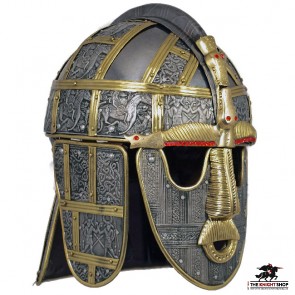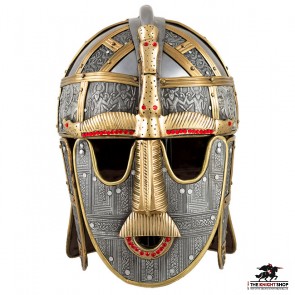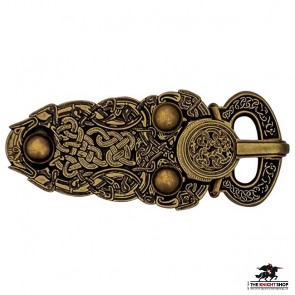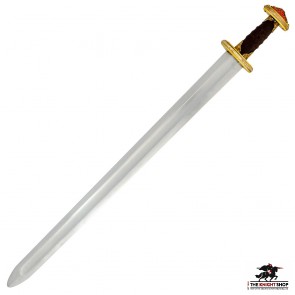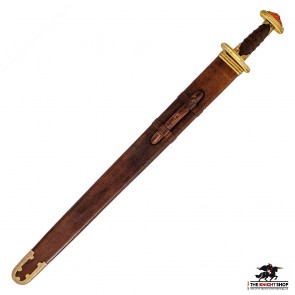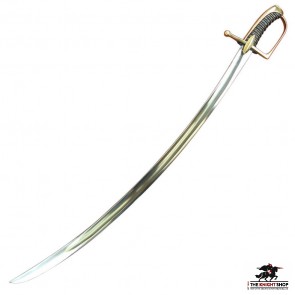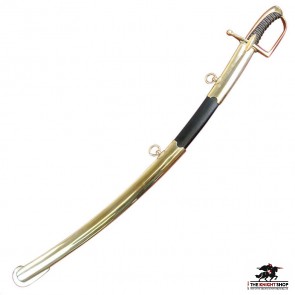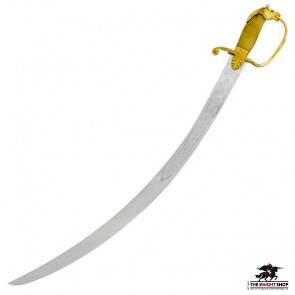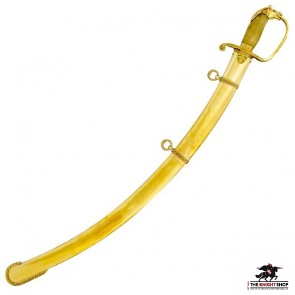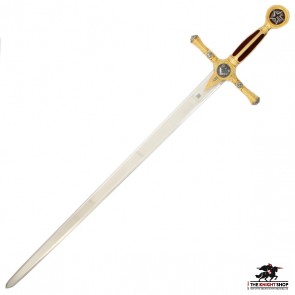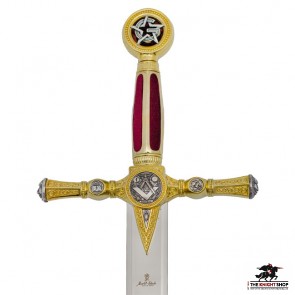Shop by Period
-
Cromwell Sword
Oliver Cromwell (1599 – 1658) was a powerful figure in English history during and after the English Civil War, when he rose from the rank of Captain of Horse to Lord Protector of England. His sword, said to have been carried at the battle of Drogheda in 1649, has been remarkably well preserved and is displayed in the permanent collection of the Royal Armouries in Leeds, England.
Learn More
The Paul Chen Cromwell Sword is an accurate replica of the original “mortuary” hilt style and features a blackened guard decorated in a gold foliage pattern with a wire-wound sharkskin grip. As the original sword now lacks a scabbard , we have provided a design typical of the period. This piece of English history is a must for the ECW collector and re-enactor.
Total length: 110.5cm
Blade length: 83.2cm
Grip length: 9.8cm
Weight: 1.47kg
Blade thickness (base): 0.5cm
Blade thickness (CoP): 0.36cm
Blade width (base): 3.4cm
Point of Balance (PoB): 8.9cm
Centre of Percussion (CoP): 53.3cm
Blade: High Carbon Steel
Edge: Sharp
Pommel: Threaded
Scabbard: Leather, Wood, Steel
All dimensions are approximate and may vary from piece to piece.Excl. Tax: £278.60 Incl. Tax: £334.32 -
Practical Mortuary Hilt Sword
The Practical Mortuary Hilt Sword is built for the reenactor. The basket is identical to that of the Hanwei SH2004 (no longer available) but the blade is unsharpened, with 1/16” edged and a rounded tip, complying with the combat rules of many re-enactment societies.
Learn More
The blade is crafted in 1065 high-carbon steel, hardened to 50HRC, which reduces edge-notching to acceptable levels while providing resilience and protection against brittleness.
Total length: 94cm
Blade length: 77cm
Weight: 907g
Blade thickness (base): 0.56cm
Blade width (base): 2.7cm
Centre of Percussion (CoP): 24cm
Blade: 1065 High Carbon Steel
Edge: Blunt
Pommel: Nut
Scabbard: Leather, Wood, Steel
All dimensions are approximate and may vary from piece to piece.Excl. Tax: £193.20 Incl. Tax: £231.84 -
Sutton Hoo Helmet
Our Sutton Hoo Helmet is one of the best replicas available to buy in the UK. It is hand crafted from steel and brass and features hinged cheek pieces and a leather lining. It is unique and unusual display piece that never fails to impress and the adjustable leather liner allows it to be worn if you so wish.
Learn More
18 gauge steel construction is not suitable for contact re-enactment.
Height: 35cm
Width: 22cm
Depth: 29cm
Weight: 3200g
All dimensions are approximate and may vary from piece to piece.
Buy the Sutton Hoo Helmet with confidence from the UK’s leading Viking helmet retailer.Excl. Tax: £197.50 Incl. Tax: £237.00 -
Sutton Hoo Belt Buckle
One of the most outstanding finds at the Sutton Hoo Ship Burial was the Great Gold Buckle. The buckle was made of gold with densely interwoven and interpenetrating ribbon animals rendered in chip-carving on the front. This stunning piece was expertly engineered by Anglo-Saxon craftsmen and was probably made for one of 4 kings: Raedwald who was overlord of the English kingdoms between AD616 and his death (at the latest in 627, probably in 625/626), Eorpwald (died 627/628) and co-regents Sigebert and Ecric, who both died fighting Penda of Mercia in AD637. The Great Gold Buckle is now on display in the British Museum.
Learn More
Comes complete with display/gift box.
Length: 12.5cm
Width: 5.3cm
Weight: 174g
Material: brass (cast)
All dimensions are approximate and may vary from piece to piece.Excl. Tax: £50.83 Incl. Tax: £61.00 -
Sutton Hoo Anglo-Saxon Sword
There are four kings that this sword may have belonged to: Raedwald who was overlord of the English kingdoms between AD616 and his death (at the latest in 627, probably in 625/626), Eorpwald (died 627/628) and co-regents Sigebert and Ecric, who both died fighting Penda of Mercia in AD637.
Learn More
Our Sutton Hoo Anglo-Saxon Sword is a based on the surviving components of an original found at the famous Sutton Hoo burial site. They can be seen on display at the British Museum. The composite hilt is made from wood and antiqued brass and is decorated with red enamel to resemble the garnets on the original. The hardwood grip is bound with brown leather and riveted to the hilt fittings in the same way as the original. It features a forged and tempered high carbon steel blade that is designed for hacking and slashing, such was the fighting style of the era. The leather bound wooden scabbard features antiqued brass fittings and a suspension loop allowing it to be fastened to a belt of baldric.
Total length: 88 cm
Blade length: 73 cm
Grip length: 11 cm
Weight: 1.2 kg
Blade thickness (base): 4.5 mm
Blade thickness (CoP): 3.7 mm
Blade width (base): 5.1 cm
Point of Balance (PoB): 16.8 cm
Blade: EN45 High Carbon Steel
Edge: Blunt
Pommel: Nut and Riveted
Scabbard: Leather, Wood, Brass
All dimensions are approximate and may vary from piece to piece.Excl. Tax: £140.00 Incl. Tax: £168.00 -
Napoleonic French Hussar Saber
Adept scouts and light cavalrymen, Napoleons Hussars could be counted upon to fight with speed and severity wherever they were deployed. Their attitude and fighting style derived from the original Hussars of Hungary and Poland in centuries past who perfected light cavalry tactics in their conflicts with the Turks. Their successes inspired a type of light cavalryman who could be seen in many European armies by the Napoleonic era, all following a rough outline of Hungarian-inspired dress, large moustaches, cavalier demeanor and arms.
Learn More
Understandably, the public romanticized the dashing, exotic image of the charging Hussar. This French Hussar saber is similar to other Hussar and cavalry sabers of the period who share a common ancestor in the Polish-Hungarian Szabla. After centuries of mounted warfare, the Szabla became the Hussar saber, ideally evolved for light cavalry combat. Its characteristic curve allowed for deathly sweeping slashes from on high. Its design highly influenced the British 1796 Light Cavalry Saber – a design destined to spread throughout the continent and to the United States.
Overall Length: 100cm
Blade Length: 84cm
Grip Length: 11cm
Weight: 975g
Edge: Blunt
Width: 32.8mm
Thickness: 7.4 - 4.2mm
Pommel: Peened
POB: 20.3cm
Blade: EN9 High Carbon Steel
Scabbard: Leather, Steel
All dimensions are approximate and may vary from piece to piece.Excl. Tax: £208.33 Incl. Tax: £250.00 -
British Officer’s Horse Head Sword - 18th Century
The British Infantry Officer did not carry a regulation infanty sword until 1786. Before this officers were responsible for choosing their own swords. Whilst swords with Lion Head pommels were a popular choice, a little rarer were those with horse head pommels, perhaps alluding to the White Horse of Hannover of the Georgian monarchs.
Learn More
Our British Officer’s Horse Head Sword features and a tempered AISI 1065 high carbon steel blade with etched decoration. The ornate brass hilt features a wood grip that is wrapped with brass wire. The scabbard is made from brass and features two fixed hanging rings.
Total length: 84.5cm
Blade length: 72cm
Grip length: 9cm
Weight: 1114g
Blade thickness (base): 0.6cm
Blade width (base): 3.7 cm
Point of Balance (PoB): 18 cm
Blade: AISI 1065 High Carbon Steel
Edge: Blunt
Pommel: Nut
Scabbard: Brass
All dimensions are approximate and may vary from piece to piece.Excl. Tax: £233.33 Incl. Tax: £280.00 -
Munich Town Watch Rapier
Our Munich Town Watch Rapier has a relatively wide blade, which makes it ideal for both functions. It is a replica of a rapier type found in many museums today: in the Munich Armory, the Bavarian Army Museum in Ingolstadt, Germany or catalogue number A612 in the Wallace Collection, for example.
Learn More
Made around 1600, this rapier has a strong, tapering blade hand forged from carbon steel with a narrow ricasso inside the finger ring. Its elegant complex basket has side guard rings and a knuckle bow. The hardwood grip is elaborately wrapped with iron wire with braided wire at the ends. A riveted pommel shaped like a flattened ball completes the hilt.
This Munich Town Watch Rapier includes a black leather scabbard with a mount and chape.
Total length: 100.5 cm
Blade length: 83.5 cm
Grip length: 8.5 cm
Weight: 1.56 kg
Blade thickness (base): 3.7 mm
Blade thickness (CoP): 3.7 mm
Blade width (base): 4.2 cm
Blade width (CoP): 2.7 cm
Point of Balance (PoB): 6 cm
Centre of Percussion (CoP): 31.5 cm
Blade: High Carbon Steel
Edge: Blunt
Pommel: Peened
Scabbard: Leather, Wood, Steel
All sizes are approximate and may vary slightly from piece to piece.Excl. Tax: £225.00 Incl. Tax: £270.00 -
Masonic Sword - Gold
Throughout history, as an instrument of justice, truth, equality, and firmness, swords have been used at every great event and have become imbued with great symbolism. For this reason, freemasons use swords in all their ceremonies.
Learn More
FREEMASONRY: “a philanthropic, institution intended to achieve an understanding of truth, the study of ethics and the practice of solidarity, working for the material and moral improvement of humanity, it is compatible with any religious or esoteric faith which does not annul the freedom of individuals”. Starting from the tradition of builders harking back to the “medieval masons and architects” freemasonry pursues the personal self-construction of the individual.
This unique MASONIC SWORD contains a great many of the symbols used in the craft, particularly the compass and set square, the plumb line and the hammer, the sacred book and the eye of the Supreme Being, and the five-pointed star inscribed in the capital “G” of the Great.
Total length: 116cm
Weight: 2.6kg
Width: 24cm
Blade: Stainless Steel
Edge: Blunt
Scabbard: None
All dimensions are approximate and may vary from piece to piece.Excl. Tax: £149.17 Incl. Tax: £179.00 -
Italian Smallsword - 19th Century
A sword of this type belonged to Ferdinand I, King of the Two Sicilies. The blade is made of steel with two edges and a hexagonal section tip. This is a light one-handed sword designed for thrusting which evolved out of the longer and heavier rapier of the late Renaissance.
Learn More
The height of the small sword's popularity was between the mid 17th and late 18th century, when any man, civilian or military, with pretensions to gentlemanly status would have worn a small sword on a daily basis.
Total length: 106 cm
Weight: 957 g
Blade: Stainless Steel
Edge: Unsharpened
Scabbard: None
All dimensions are approximate and may vary from piece to piece.Excl. Tax: £41.67 Incl. Tax: £50.00










